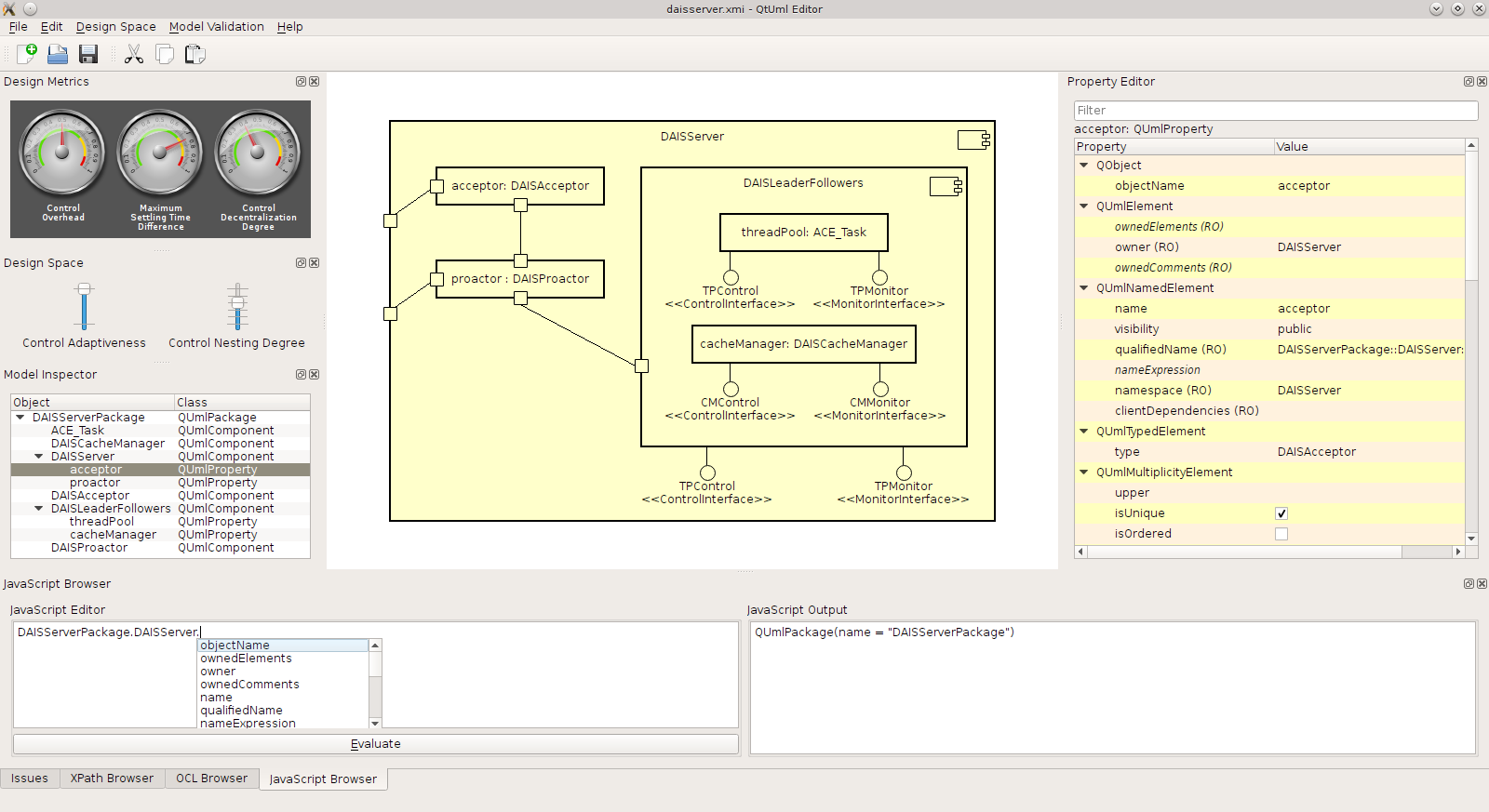QtModeling
The Qt Modeling add-on module aims at providing basic model-driven features, such as the definition, storage, and manipulation of MOF/UML-based models as well as supporting new user-defined languages.
Rationale
Qt Modeling Framework rationale has been driven by the following desired properties:
- We should support automatic code generation as much as possible. Only 8.17% of UML 2.4.1 meta-model properties are declared as ‘derived’ (and not derived unions), which prevent automatic code generation. For those properties, the specification provide the guidelines for implementation but maybe some of them could be automatically derived from their OCL specifications. QtMof and QtUml libraries already provides a mapping from UML to Qt5 by first generating a more Qt-ish representation of a UML model (XQuery-based xmi to qtxmi conversion) and then generating source code from a couple of well-design templates. Such infrastructure has successfully been used to generate the initial skeletons of QtMof and QtUml and can also be used to convert user-defined UML models into Qt5 source code. As a consequence, we hopefully end up with a faithful implementation of OMG’s standardized meta-models.
- We should leverage the development of meta-model-agnostic tools for editing, analysing, and converting any MOF-based model. By having no compile-time commitments with any specific MOF-based meta-model, such tool would be also able to handle other MOF-based meta-models (such as CWM) or even user-defined meta-models.
QtMof and QtUml should provide a powerful modeling notation for early analysis of MOF-based models. A number of preset scripts for checking well-formed rules should be available and specific scripts may be defined by the user. OCL is a potential candidate as script language, but XQuery or even QtScript can also be considered. That would make possible, for example, analysis of conformance to architectural styles/patterns, continuously integrated models, and so on.
- A flexible mechanism for mapping of models into middleware/framework-specific artifacts should also be provided. A uml2qt mapping is already in place, but new ones should be easily defined.
- High adherence to OMG standards. That includes avoiding unjustified proprietary extensions. We should consider Diagram Definition specification when exporting/importing diagrams. UML 2.5 is on beta stage. QVT could also be supported in the future.
Current Status
The following features are already supported in Qt Modeling:
- UML 2.4.1 meta-model implementation
- MOF 2.4.1 meta-model implementation
- QtUmlEditor: model-agnostic (plugin-based) editor with full capabilities for model creation and XMI serialization
- Programmatic model manipulation via QtScript
Roadmap
Expected features (probably not in first Qt Modeling release) include:
- Refactoring for wrappedobjects-free implementation of meta-models
- OCL parser
- QML-based (extensible plugin-based) concrete syntax
- Enhanced code-generation architecture
Basic Usage
To link against the Qt Uml module, add this line to the project file:
QT += uml
Include the required headers:
#include <QtUml/QUmlModel>
#include <QtUml/QUmlPackage>
#include <QtUml/QUmlPrimitiveType>
#include <QtUml/QUmlEnumeration>
And then you can programmatically create your models:
QWrappedObjectPointer<QModel> model = new QModel;
model->setName("MyModel");
QWrappedObjectPointer<QPackage> package = new QPackage;
package->setName("Package1");
QWrappedObjectPointer<QPrimitiveType> primitiveType = new QPrimitiveType;
primitiveType->setName("String");
QWrappedObjectPointer<QEnumeration> enumeration = new QEnumeration;
enumeration->setName("DirectionKind");
QWrappedObjectPointer<QEnumerationLiteral> directionIn = new QEnumerationLiteral;
directionIn->setName("DirectionIn");
enumeration->addOwnedLiteral(directionIn);
QWrappedObjectPointer<QClass> class_ = new QClass;
class_->setName("Student");
class_->setAbstract(false);
package->addOwnedType(enumeration);
package->addOwnedType(class_);
model->addPackagedElement(package);
model->addOwnedType(primitiveType);
// query model or perform 'well-formed/sanity/architectural conformance' checks
delete model.data();
Maybe do some XMI serialization:
QFile file("test.xmi");
if (!file.open(QFile::WriteOnly | QFile::Text)) {
qDebug() << "Cannot write file !";
return 1;
}
QXmiWriter writer(model);
if (writer.writeFile(&file))
qDebug() << "XMI file saved !";
else
qDebug() << "Error when writing XMI file !";
file.close();
Projects using Qt Modeling
Qt Modeling has been motivated by and constitutes the basic model-driven platform for the DuSE-MT project. DuSE is a flexible and extensible approach for architectural design spaces based on MOF (Meta Object Facility) and UML (Unified Modeling Language) technologies. DuSE defines a model-based meta-architecture which includes: i) a self-adaptation design space representation; ii) changes to be enacted in target system’s original model when navigating through the design space; iii) OCL rules which define valid variation points in each dimension; and iv) a set of metrics to guide architects during design trade-off analysis.
DuSE is a research project and an open source initiative carried out at Federal University of Bahia (UFBa) and Federal Institute of Education, Science and Technology of Bahia (IFBa). The developers of DuSE are contributors of KDE / Qt Project and members of the Distributed Systems Laboratory (LaSiD), a research center created in 1995 and that has performing researchs in the fields of Distributed Systems, Fault Tolerance, Real-Time, Mobile Agents, and Mechatronic Systems.

DuSE-MT integrates DuSE’s design spaces meta-model, algorithms, and mechanisms into an extensible and user-friendly supporting tool. DuSE-MT defines a flexible architecture which enables the use of connector plugins for system identification in a range of platforms. Each connector plugin enables the probing of target systems developed for that specific platform, gathering input/output relationships between system’s controlled/measured parameters and allowing off-line and on-line system identification.
Contribute !
All contributions are pretty welcome as usual. All development is done through Gerrit. Therefore, those wishing to be involved in the development process must have a Qt developer account. More information about the registration process and development can be found here.
For those of you who want just trying it out, simply clone the Qt Modeling repository:
git clone git://code.qt.io/qt/qtmodeling.git
For more options enter repository browser.